Premium Only Content
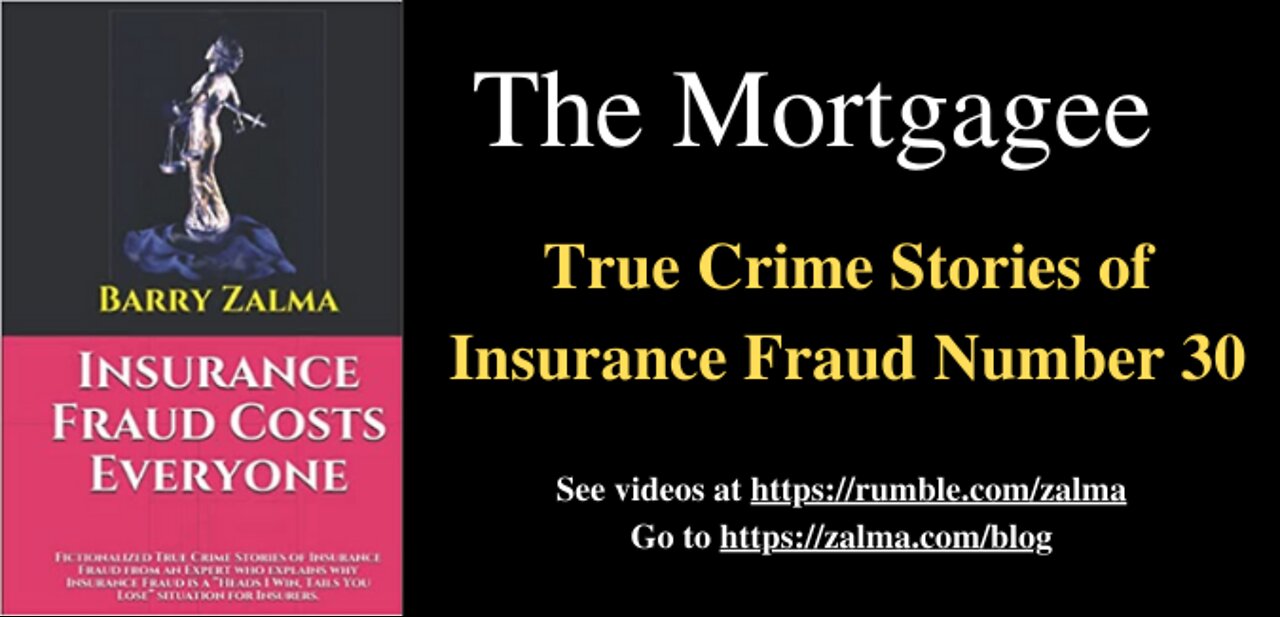
The Mortgagee
True Crime Stories of Insurance Fraud Number 30
Barry Zalma, Esq., CFE presents videos so you can learn how insurance fraud is perpetrated and what is necessary to deter or defeat insurance fraud. This Video Blog of True Crime Stories of Insurance Fraud with the names and places changed to protect the guilty are all based upon investigations conducted by me and fictionalized to create a learning environment for claims personnel, SIU investigators, insurers, police, and lawyers better understand insurance fraud and weapons that can be used to deter or defeat a fraudulent insurance claim.
As insurance companies become more sophisticated in the tools needed to defeat insurance fraud, the frauds become more complex. Those who earn a dishonest living stealing from insurance companies find that the simple, straightforward fraud, is no longer successful. They have become insurance scholars to learn better ways to steal from insurance companies.
The 1942 banking industry wrote a document known as the standard or union mortgage clause [Form 438 BFUNS] to protect mortgage holders from dishonest borrowers. The banks were concerned because occasionally their borrowers committed arson and the insurers refused to pay. The policy was declared void as a result of the arson and resulting fraud and neither the insured nor the mortgagee recovered.
As a condition of allowing their borrowers to buy insurance from particular companies, the banks insisted that the companies attach to their policies a union mortgage clause. The clause provided that if the borrower, by act or omission, caused the policy to be void, it would only be void as to the interest of the borrower and not the lender. Therefore, even if an insurer proved that its insured burned the building down, it still must pay the mortgagee its interest. The contract between the mortgagee and the insurer was a separate and distinct policy. The insurer could only defeat it if the mortgagee had knowledge of an increase of hazard.
The union mortgage clause gave security to honest and reputable lenders. It also gave a dishonest lender the means to commit an arson for profit without the possibility of loss or criminal prosecution.
The fraud would work with the insurance criminal first buying a distressed dwelling at a foreclosure sale for less than its true value. With a coconspirator, he would arrange a mortgage on the dwelling for three times the amount paid. He would then buy a homeowners policy from an unsuspecting insurer, naming the mortgagee under a standard or union mortgage clause.
Before the first installment was due on the premium financing the dwelling would burn to the ground. Gasoline would be found on the premises and the local fire arson unit would conclude that the fire was intentionally set.
The building would be vacant and without contents. The named insured, the alleged borrower who had used a fictitious name in the purchase of the insurance, would disappear. He would not even give notice of the claim. The lender would submit a proof of loss claiming that its entire interest was destroyed. It would also make claim for the full policy limits, providing a copy of the mortgage instruments to establish its claim.
The insurer, convinced that the insured set fire to the dwelling, and unable to reach him, would be thankful that it had no contents or additional living expenses to pay. It would write the named insured at his last known address denying his claim for failure to cooperate. They would pay the mortgagee’s claim in full.
Usually, the insurer, not wishing to get into the mortgage business, would not even request an assignment of the mortgage debt. The lender, paid more than the original price for the fire damage to the dwelling would issue a notice of foreclosure and sell the property at a foreclosure sale as an empty lot. The original named insured would share half the proceeds of the insurance policy with the mortgagee and would also receive 50 percent of the monies received from the foreclosure sale of the empty lot. The insurer, with no way of proving the conspiracy would close its file. The insurer believed that an arsonist had not succeeded in his crime. The insurer had no choice but to pay the “innocent” mortgagee.
This type of fraud continues. Unscrupulous lenders invest their profits in distressed properties, both residential and commercial. The losses they report are not always fire. Some more imaginative insurance criminals use the vandalism coverage to provide a more profitable fraud. First, they avoid the hazard of physical injury when setting an arson fire. They also avoid arrest if accidentally seen committing the arson. Second, by judiciously vandalizing the structure, the mortgagee and the named insured find that they can have a distressed property totally remodeled and restored at no cost. The borrower, shortly after taking possession, would take a three-pound sledge hammer and punch a single hole in every sheet of drywall in every room, a single hole in every cabinet door, a single hole in every passage way door breaks each porcelain fixture in the baths, break the lock and put a single hole in the front and rear entry door. He would also dent or damage the central heating system and cut jagged slashes through the carpeting.
The borrower, and named insured, would then disappear, since the entire transaction was a sham with fake names and identification. The mortgagee, claiming discovery of the damage on an inspection trip to decide why the payments had not been made, would report a vandalism claim. The mortgagee, knowledgeable about insurance, would have records showing that the premises were occupied less than thirty days before the discovery of the vandalism.
The insurer, in good faith, would agree to a scope of damage requiring the replacement of all of the drywall, the repainting of all of the rooms, the replacement of the carpet and all of the plumbing furnishings and fixtures. The mortgagee would agree to an actual cash value settlement. Then, using its own employed workmen, the mortgagee would repair the drywall with patching plaster, caulk fixtures and for one tenth of the cost of a reconstruction contractor would totally remodel the house. The mortgagee would then conduct a foreclosure sale and sell the remodeled house. The mortgagee would profit by both the receipt of the cost of repairs and the profit on the sale of the now remodeled and restored house. The mortgagee and the borrower would split the proceeds equally and start the cycle over with a new house.
© 2022 – Barry Zalma
Barry Zalma, Esq., CFE, now limits his practice to service as an insurance consultant specializing in insurance coverage, insurance claims handling, insurance bad faith and insurance fraud almost equally for insurers and policyholders.
He practiced law in California for more than 44 years as an insurance coverage and claims handling lawyer and more than 54 years in the insurance business.
Subscribe to “Zalma on Insurance” at https://zalmaoninsurance.locals.com/subscribe and “Excellence in Claims Handling” at https://barryzalma.substack.com/welcome.
You can contact Mr. Zalma at https://www.zalma.com, https://www.claimschool.com, zalma@claimschool.com and zalma@zalma.com . Mr. Zalma is the first recipient of the first annual Claims Magazine/ACE Legend Award.
You may find interesting the podcast “Zalma On Insurance” at https://anchor.fm/barry-zalma; you can follow Mr. Zalma on Twitter at; you should see Barry Zalma’s videos on https://www.youtube.com/channel/UCysiZklEtxZsSF9DfC0Expg/featured; or videos on https://rumble.com/zalma. Go to the Insurance Claims Library – https://zalma.com/blog/insurance-claims–library/ The last two issues of ZIFL are available at https://zalma.com/zalmas-insurance-fraud-letter-2/
-
 8:36
8:36
Barry Zalma, Inc. on Insurance Law
1 year agoZalma's Insurance Fraud Letter - January 15, 2024
287 -
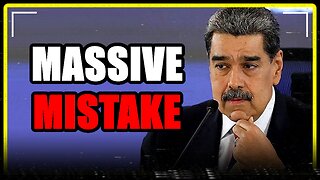 8:10
8:10
MattMorseTV
11 hours ago $1.18 earnedTrump's "SURPRISE" for MADURO.
12.8K13 -
 12:11
12:11
Nikko Ortiz
1 day agoCrashout 6 Rumble
22.7K3 -
 24:39
24:39
GritsGG
11 hours agoINSANE Ranked Game on Warzone!
2.42K1 -
 LIVE
LIVE
Lofi Girl
2 years agoSynthwave Radio 🌌 - beats to chill/game to
178 watching -
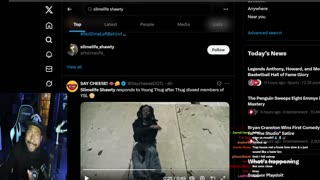 5:52:00
5:52:00
Akademiks
7 hours agoWAR IN ATLANTA Episode 5. YOUNG THUG FIRST INTERVIEW about SNITCHING, GUNNA... BREAKS DOWN CRYING!
129K6 -
 7:30:25
7:30:25
SpartakusLIVE
10 hours agoVerdansk Duos w/ Nicky || Saturday Spartoons - Variety Later?!
51.7K1 -
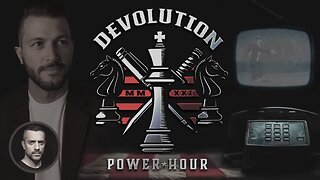 1:38:47
1:38:47
Badlands Media
1 day agoDevolution Power Hour Ep. 387: Trump, Epstein, Durham Mysteries, and North Korea Ops
84.3K20 -
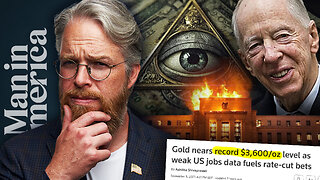 1:05:23
1:05:23
Man in America
14 hours agoSoaring Gold Exposes the Imminent Crash of the Old System w/ John Perez
39.5K7 -
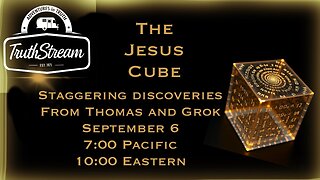 2:42:40
2:42:40
TruthStream with Joe and Scott
14 hours agoTHOMAS AND GROK: AI, Bible decodes, The JESUS Cube live 9/6 #487
29.9K2